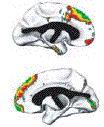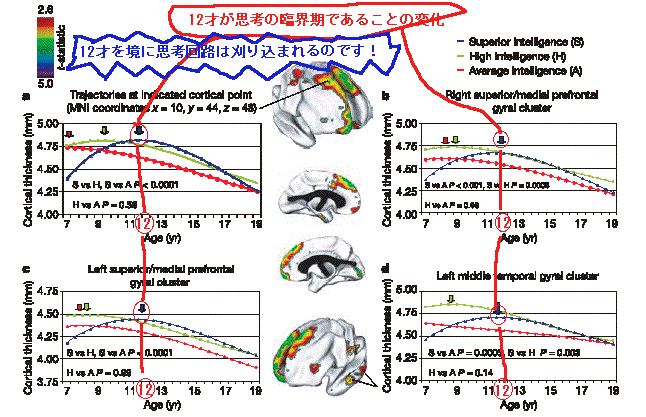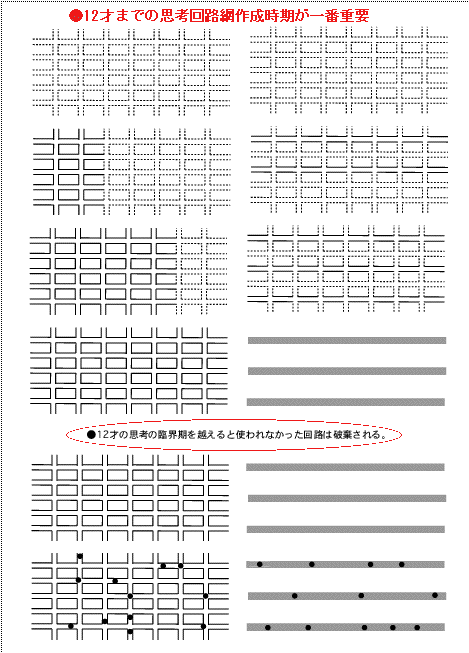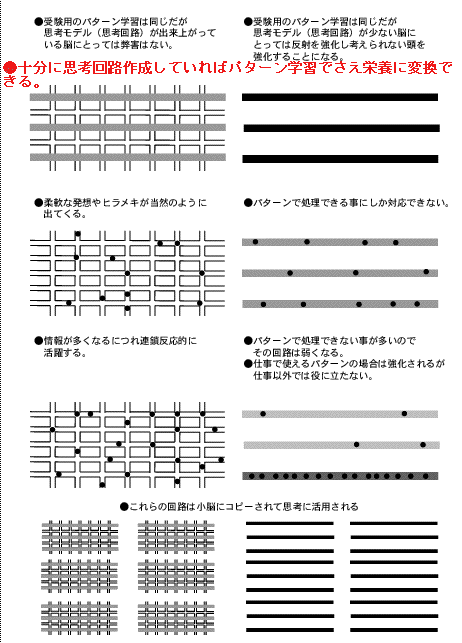 】
】【総索引】【幼児・児童期の<危険な脳の活性化>崇拝】【残虐で幼稚な犯罪の元凶と予防策】
【2006.10/15】...ときどき日記より引用
http://plaza.rakuten.co.jp/donguriclub/diary/
●脳内進化エネルギー(文責:どんぐり倶楽部・T.Itoyama) [ 学習理論 ]
●脳は進化するまでに使えるエネルギー(進化用の特別養分と考えても良い)が個人によって生まれつき決まっている。また、進化に使える期間は最長でも性成
熟年齢である12才までの12年間である。さらに、思考回路網を伝わる情報の伝達スムーズ度も生まれつき決まっており生涯変わらない。本当のIQである。
これらの基礎概念があるとGieddが発表したデータを解析することが出来る。
http://homepage.mac.com/donguriclub/nature-vol440.html
●恐ろしいほど無知な専門家
・論文(英文):http://www.nature.com/nature/journal/v440/n7084/abs/nature04513.html;jsessionid=A7EAC62A2663965AE49BDAFE2F15F0FD
・論文が掲載された雑誌:Nature誌 2006年440号676-679頁(Shaw, Greenstein, Lerch,
Clasen, Lenroot, Gogtay, Evans, Rapoport and Giedd)
・重要なデータを載せている上記論文について日本の<専門家>は
>「どうしてIQの高い子供の方で発達の遅れが観察されるのかはまだ不明で〜」
とか
>「脳が大きい(つまり灰白質の量が多い)人が賢いのではなく、皮質発達の変化の仕方が学力要請に重要なのではないか〜」
などとコメントしている。
●??です。「余裕」を「遅れ」と捉えて<不明>で納得しているのだからお先真っ暗です。
●大きさに関しては何十年も前に関係ないことは分かっている(絶対学力でも言及している)し、「皮質発達のダイナミックな変化の動態が知能の高さには重要
なのではないか」ではなく、変化の時期が決定的な頭の良さを保証するのは明白である。しかし、気付きもしない。このデータの表していることは「IQが高い
(処理抵抗が低いので少量のエネルギーで外界刺激の処理を出来る)ので臨界期に近い高学年でのより複雑な処理を高度な思考回路作成をしながらできる」と言
うことです。つまり、臨界期ギリギリまでの期間を最大限に使って高度な回路を増加させることができるので<頭が良く>なるのだ。だから、IQに関係なく幼
児・児童期の早期の知的系統的教育は本当の学力衰退に繋がるのです。
2006.9/16...Smart Kids May Get a Slow
Start
2006.8/22...NATURE掲載記事←詳しい論文はコチラ

……………………………………………………………………………………………
●上記はNature紙に掲載されたデータです。
●下記は「どんぐり倶楽部」の理論をモデル化したものです。体験から感じることは12才の臨界期は11才であることもあるようでしたが、それは女性の特徴
かも知れません。性成熟と関連していると予測していますが、秘密です。こちらも将来的には脳科学が「どんぐり倶楽部」の後追い検証をしてくれるでしょう。
Giedd博士が有力候補ですね。京大か理研も期待できますが、時間がかかると思います。


……………………………………………………………………………………………
2006.6/4...12才が「思考の臨界期」で
あり、早期教育が無駄なこと、前倒しは意味がないこと、12才までにすべきことは、新しい思考モデル(思考回路)作成ができない(邪魔をする)「暗記・暗
算・高速反応」ではなく思考回路を増加させること(例えば「良質の算数文章問題」を絵図で解くこと・工夫すること)しかないということの実証データを示し
た決定的な論文を見つけた。12才(女子は11才)で大脳皮質の活動組織である灰白質の増加ピークを過ぎる。すると、過剰神経回路網は破棄され、それに伴って灰白質は薄くなるのだ。また、思考に関する小脳の重要な関与(私が書いていた小脳自動思考)についても述べられていた。米国国立精神衛生研究所の神経科学者Gieddの論文である。
<抜粋>In the frontal part of the brain, the part of the brain involved
in judgment, organization, planning, strategizing -- those very
skills that teens get better and better at -- this process of
thickening of the gray matter peaks at about age 11 in girls and
age 12 in boys, roughly about the same time as puberty. After that peak, the gray matter thins as the
excess connections are eliminated or pruned.
……………………………………………………………………………………………
出典:http://www.nimh.nih.gov/press/prbrainmaturing.cfm)NEDO海外レポートNO.933,
2004. 6/16-22【産業技術】ライフサイエンス:画像研究で脳の発達過程を解明(米国)
論理的思考や問題解決を司る脳の中枢は最後に成熟する部位であることを、最新の研究が画像で明らかにした。4 歳から21 歳の被験者を対象に、10
年に渡って磁気共鳴画像化法(MRI)で正常な脳の発達を調べる研究で、国立精神衛生研究所(NIMH)とカリフォルニア州立大学ロサンゼルス校(UCLA)は前前頭皮質などの脳の“高次機能”中枢は青年期まで完全には発達を終えないことを明らかにした。5
歳から20 歳までの被験者の15 年間に及ぶ脳の成熟を数秒に圧縮する時間差撮影
の三次元の動画は、おそらく使用されない神経接続が十代で廃棄されるのを反映して、大脳皮質の活動組織である灰白質が後頭部から前頭部へ向かって徐々に縮
小することを明らかにしている。大脳皮質部位の成熟は、(大脳皮質が)関係する認知や機能発達において画期的な出来事が起こる年齢で確認される。NIMH
のNitin Gogtay 博士、Judith Rapoport 博士、UCLA のPaul Thompson 博士、Arthur
Toga 博士と研究員らは、成熟の順序がだいたい哺乳類の脳の進化と一致することも示唆している。この研究は2004 年5 月17
日の週の米科学学会会報オンライン版で発表された。「統合失調症のような神経発達障害で見られる脳の変化を解明するには、脳の正常な発達過程についてもっ
と良く理解することが必要だった。」とRapoport
博士は説明する。研究員らは、健康な13 人の児童と十代の若者を成長にあわせて2 年に1 度、10
年間に渡って(MRI)スキャンを行った。そのスキャン結果を全てまとめて登録し、脳の解剖学的な特徴群を利用して、灰白質[ニューロンとその樹状突起]
の盛衰を視覚化し、全てのデータを合成し5
歳から20 歳までの脳の成熟を示す動画となるマップを作製した。出生直後の18
ヶ月間に過剰産生によって灰白質が急増した後、使用されない神経回路が廃棄されるにつれ、(灰白質は)恒常的に減少すると長く考えられていた。その後、
1990
年代後半に今回の研究の共同執筆者でもあるNIMH のJay Giedd
博士らが思春期の直前に灰白質過剰産生の第二波があり、その後、使用されない神経回路の廃棄の第二回目が十代(女子は11才、男子は12才)のうちに起こ
ることを発見した。今回の研究で、最初に成熟する部位(脳の最前部及び最後部など)は感覚の処理や動作など最も基本的な機能を担う部位であることが分かっ
た。空間知覚や言語に関連する部位(頭頂葉)がそれに続き、さらに高度の機能[感覚からの情報の統合や論理的思考、その他“高度”機能を司る部位(前前頭
皮質)]は最後に成熟する。
……………………………………………………………………………………………
●早期の知的系統的学習が無意味であり弊害をもたらすということ。
●幼児・児童期の単純思考の徹底反復は様々な思考モデル(思考回路)養成の妨害となるということ。
……………………………………………………………………………………………
●つまり、思考回路の破棄が行われる12才直前に抽象思考が完成する。しかし、熟成部位の順番はプログラムされているのだから抽象思考を早期にさせてはい
けない。抽象思考の基本は情報のリダクション(省略・縮小)なので思考モデル(思考回路)を使わないことになるので、具象回路から抽象回路に変換するため
の素になる回路が少なくなってしまうからである。見かけは格好良いが実は大変なそんをしているのだ。だから、文章問題を線分図などの記号ではなく絵図で丁
寧に描いて解くことが非常に大事なのだ。具象思考を十分に経験し味わう時間を転換期(思考モデル(思考回路)刈り込み記の12才)ギリギリまで伸ばす方が
思考回路は数多く確保されるのです。具象思考回路を抽象思考回路に転換させる時期は9-12才である。この間は「具象思考」「具象思考回路を抽象思考回路
へ変換」「抽象思考回路の試運転」等が同時に行われるので大脳皮質の厚みはピークになる。そして、回路が固定され、12才以後は不要な回路・使われなかっ
た回路は破棄される。これからが本当の思考が出来る時期になり、情報を多量に入力してもいい時期になる。もちろん、高速思考も必要ならば練習可能です。
従って、様々な思考モデル(思考回路)を12才までに作る環境を与えずに最も単純で何の新しい思考モデル(思考回路)も作り出せない「暗記・暗算・高速反
応」特に高速単純計算を幼児・児童期にさせていては最低の思考モデル(思考回路)しか育てられない。知識量やスピードは思考モデル(思考回路)が固定する
12才以降に入力すべきものなのです。
……………………………………………………………………………………………
【開発という名の破壊活動】リゾート開発とは自然破壊のこと、才能開発とは個性破壊のこと。能力は開発すればいいというものではない。幼児期に目ざめさせ
ては行けない能力もある。時期がずれているときに発揮される能力は害になる。害になるから自然には発達しないようにプログラムされているのです。幼児期に
目ざめた能力は一生の性格になる。人間はあらゆるものを楽しむ能力を持っている。しかし、あらゆる者を楽しめることは実は恐ろしいことです。どんなに不自
然なことでも非道徳的なことでも、そこに快楽を感じることができる。ここに教育の重要性がある。特に幼児教育の重要性がある。開発してはいけないこと。目
ざめさせてはいけない能力がある。これを知らずに行う教育や開発は暗闇の中で射撃練習をするようなものだ。幼児期にテレビゲーム・・・・に快楽を感じるよ
うな能力を開花させる必要はない。高速計算を喜ぶ能力は害になるだけである。スピードに憧れる必要もない。
【小学校での表現力養成が危ない理由】何かを伝えるのに言葉(文)の練習をすれば上手になると思っている。プラトンのアカデメイアとイソクラテスの学校の
ことを知っているのだろうか?表現を磨くのは確かに見栄えがして格好良い。しかしそれは<入力↓消化↓オリジナル>の全てが終わってからだ。そうでなけれ
ば表現は子供の持っている才能や個性を制限し、単なる誰かの「上手な猿真似」にしかならない。
●早期教育・幼児教育はアメリカが最先進国です。しかし、その最先端の情報は日本ではあまり知られていません。なぜならば、早期教育・幼児教育に携わる殆
どの人々の職を奪うことになりかねないからです。つまり、早期の系統的教育はその子の能力を開発するのではなく制限し、才能を潰し、性格を攻撃的にする可
能性が大きいという報告が多数あるからです。
……………………………………………………………………………………………
●ここに「ミスエデュケーション(デイヴィッド・エルキンド著)」という本があります。筆者は児童心理学者・米マサチューセッツ州タフツ大学教授・全米幼
児教育会会長です。彼の考えは「どんぐり倶楽部」の考えとよく似ています。資料とともに抜粋を載せておきます。「体験的学習というポイントを無視して子ど
もに何かを教え込もうとするのは誤った教育です。例えば、フラッシュカードは不要な冷たいコミュニケーションを強いることになるので、将来の学習にとって
なくてはならない愛着と信頼感を損なう結果となり、子どもにとっては百害あって一利なしと言わざるを得ません。また、象徴的・派生的学習の準備ができてい
ない子どもに系統的教育(早期教育)を押しつけることの弊
害は、すでに多くの証拠によって裏付けられています。例えば、早期教育を受けた子どもと受けなかった子どもとを15才まで追跡調査した研究によると、受け
た子どもの方が10代になってから非行に走る割合が明らかに高かったのです。別の研究では早期教育を受けた子どもの方が小学校に上がってから、より攻撃的
な態度を示すことが明らかになりました。さらに、1800年代の初め、米マサチューセッツ州では2〜4才の子どものおよそ3割が学校に通って読み書きを習
わせられていました。また、同じ時代のイギリスでもロバート・オーエンが早期教育を推進しようとしました。ところが、結局どちらの試みも失敗に終わり幼児
に読み書きを教えることはなくなったのです。」つまり、幼児期には情緒の安定が最優先であり、学習は体験的学習に限るということです。
【計算だけでも?...まずは計算から???】
■文章問題の中には必ず計算する部分があるのを忘れていませんか?「文章問題の前にまずは計算問題」というのは全くの無駄なんです。いつになったら文章問
題を始めるのでしょう。いつになったら考える練習を始めるのでしょう。一番大事なことを一番吸収力の高いときにしないでどうして先送りするんでしょう。目
の前にある最大のチャンスを見向きもしないなんて「もったいない」限りです。
また、せっかく文章問題を解いているのに絵図で考えることをしないで文章から式を立てようとしている人がいますがこれも大きな勘違いです。視覚イメージを
意識せずに解く文章問題は考える力を育てる材料にはなりません。しないよりはマシですが、非常に効率の悪い方法です。なぜなら、非常に大くの問題を解けば
中には視覚イメージ操作をする子も偶然に出てくるので、その子は考える力を得ることが出来ます。しかし、これは偶然です。最初から、キチンと考えるとはど
ういうことかを教えれば子供達は100%考えることができるようになります。偶然に頼って教育をすべきではありません。無意識に立式する事だけにエネル
ギーを使ってしまう症状を立式病と言います。
【暗記について】
■最も効率の悪い学習方法が忘れないように(忘れることを恐れて)徹底反復する「覚え続けていること=いつも反射的に応えられる状態にしておくこと」です。これではいつまでたっても応用の利く深い学習はできません。深思考。
■学力向上の簡単な方法
1.数少ない良質の宿題を出す(↓「分からん帳」まで作る)
2.遊びと工夫された宿題は必ずさせる(遊びが優先・考えない宿題はなるべくさせない)
3.1週間に1時間だけは保護者と一緒に「良質の算数文章問題」をする(保護者は別の問題をする方がいい)
これだけで学力は向上します。2.3.は簡単ですが問題は1.です。「お粗末3点セット」を「お見事3点セット」にしなければ不可能です。
■少なくとも小学校時代(思考回路作成時期)の暗記と計算のテスで満点を取るために使っている時間は考えない力(反射的学習)を身に付けている時間で、悪影響を及ぼす危険性が非常に大きい時間です。
■反射(反射的学習:スピード教育)が恐ろしいのは「無意識にしてしまう」からです。
自分の人間らしい感情を無視して実行してしまう習慣を強化しているからです。「とにかくすればいい」は成長途上の脳にとっては絶対的な命令になるんです。
つまり「考えないで動け」ということと同じです。非常に危険な脳を育てます。ただし、毎回状況が変化するスポーツなどでは「考えないで動け」という場合で
も常に状況判断(考えること)をしながらの行動ですから悪影響はありませんし、主体的な工夫が加わっていれば学力養成にさえなります。問題は最低の作業
(単純思考)の反復である「暗記・暗算・高速反応」その中でも高速計算の徹底反復です。これだけは、どう工夫しても悪影響から逃れることは出来ません。特
に思考(計算も単純思考)することに反射を使うことは幼稚な思考であれば幼稚な行動に直結するということです。反射的思考を養成して「幼稚で残虐で短絡的
なことをするように育て」ておきながら、幼稚で残虐で短絡的な犯行があると「原因が分からない」という。分かるはずがない。分かっていれば、そんな教育は
しないのだから。
------------------------------------------------------------------------
Press ReleaseMay 17th, 2004Contact: Jules AsherNIMH
Press Office301-443-4536NIMHpress@nih.gov
Imaging Study Shows Brain Maturing
The brain's center of reasoning and problem solving is among the
last to mature, a new study graphically reveals. The decade-long
magnetic resonance imaging (MRI) study of normal brain development,
from ages 4 to 21, by researchers at NIH's National Institute
of Mental Health (NIMH) and University of California Los Angeles
(UCLA) shows that such "higher-order" brain centers,
such as the prefrontal cortex, don't fully develop until young
adulthood.
A time-lapse 3-D movie that compresses 15 years of human brain
maturation, ages 5 to 20, into seconds shows gray matter ― the
working tissue of the brain's cortex ― diminishing in a back-to-front
wave, likely reflecting the pruning of unused neuronal connections
during the teen years. Cortex areas can be seen maturing at ages
in which relevant cognitive and functional developmental milestones
occur. The sequence of maturation also roughly parallels the evolution
of the mammalian brain, suggest Drs. Nitin Gogtay, Judith Rapoport,
NIMH, and Paul Thompson, Arthur Toga, UCLA, and colleagues, whose
study is published online during the week of May 17, 2004 in The
Proceedings of the National Academy of Sciences.
"To interpret brain changes we were seeing in neurodevelopmental
disorders like schizophrenia, we needed a better picture of how
the brain normally develops," explained Rapoport.
The researchers scanned the same 13 healthy children and teens
every two years as they grew up, for 10 years. After co-registering
the scans with each other, using an intricate set brain anatomical
landmarks, they visualized the ebb and flow of gray matter - neurons
and their branch-like extensions - in maps that, together, form
the movie showing brain maturation from ages 5 to 20.
It was long believed that a spurt of overproduction of gray matter
during the first 18 months of life was followed by a steady decline
as unused circuitry is discarded. Then, in the late l990s, NIMH's
Dr. Jay Giedd, a co-author of the current study, and colleagues,
discovered a second wave of overproduction of gray matter just
prior to puberty, followed by a second bout of "use-it-or-lose-it"
pruning during the teen years.
The new study found that the first areas to mature (e.g., extreme
front and back of the brain) are those with the most basic functions,
such as processing the senses and movement. Areas involved in
spatial orientation and language (parietal lobes) follow. Areas
with more advanced functions ― integrating information from the
senses, reasoning, and other "executive" functions (prefrontal
cortex) ― mature last.
In a related study published a few years ago, Rapoport and colleagues
discovered an exaggerated wave of gray matter loss (PDF file)
in teens with early onset schizophrenia. These teens, who became
psychotic prior to puberty, lost four times the normal amount
of gray matter in their frontal lobes, suggesting that childhood
onset schizophrenia "may be an exaggeration of a normal maturation
process, perhaps related to excessive synaptic pruning,"
note the researchers. By contrast, children with autism show an
abnormal back-to-front wave of gray matter increases, rather than
decreases, suggesting "a specific faulty step in early development."
Also participating in the new study were: Leslie Lusk, Cathy Vaituzis,
Tom Nugent, David Herman, Drs. Deanna Greenstein, Liv Clasen,
NIMH; Kiralee Hayashi, UCLA.
NIMH is part of the National Institutes of Health (NIH), the Federal
Government's primary agency for biomedical and behavioral research.
NIH is a component of the U.S. Department of Health and Human
Services.
Time-Lapse Imaging Tracks Brain Maturation from ages 5 to 20
ハ
Constructed from MRI scans of healthy children and teens, the
time-lapse "movie", from which the above images were
extracted, compresses 15 years of brain development (ages 5ミ20)
into just a few seconds. Red indicates more gray matter, blue
less gray matter. Gray matter wanes in a back-to-front wave as
the brain matures and neural connections are pruned. Areas performing
more basic functions mature earlier; areas for higher order functions
mature later. The prefrontal cortex, which handles reasoning and
other "executive" functions, emerged late in evolution
and is among the last to mature. Studies in twins are showing
that development of such late-maturing areas is less influenced
by heredity than areas that mature earlier.
Source: Paul Thompson, Ph.D.
UCLA Laboratory of Neuroimaging
Press ReleaseMarch 29, 2006Contact: Jules AsherNIMH Press
Office301-443-4536NIMHpress@nih.gov
Cortex Matures Faster in Youth with Highest IQ
Youth with superior IQ are distinguished by how fast the thinking
part of their brains thickens and thins as they grow up, researchers
at the National Institutes of Health's (NIH) National Institute
of Mental Health (NIMH) have discovered. Magnetic resonance imaging
(MRI) scans showed that their brain's outer mantle, or cortex,
thickens more rapidly during childhood, reaching its peak later
than in their peers ― perhaps reflecting a longer developmental
window for high-level thinking circuitry. It also thins faster
during the late teens, likely due to the withering of unused neural
connections as the brain streamlines its operations. Drs. Philip
Shaw, Judith Rapoport, Jay Giedd and colleagues at NIMH and McGill
University report on their findings in the March 30, 2006 issue
of Nature."Studies of brains have taught us that people
with higher IQs do not have larger brains. Thanks to brain imaging
technology, we can now see that the difference may be in the way
the brain develops," said NIH Director Elias A. Zerhouni,
M.D. While most previous MRI studies of brain development compared
data from different children at different ages, the NIMH study
sought to control for individual variation in brain structure
by following the same 307 children and teens, ages 5-19, as they
grew up. Most were scanned two or more times, at two-year intervals.
The resulting scans were divided into three equal groups and analyzed
based on IQ test scores: superior (121-145), high (109-120), and
average (83-108).The researchers found that the relationship between
cortex thickness and IQ varied with age, particularly in the prefrontal
cortex, seat of abstract reasoning, planning, and other "executive"
functions. The smartest 7-year-olds tended to start out with a
relatively thinner cortex that thickened rapidly, peaking by age
11 or 12 before thinning. In their peers with average IQ, an initially
thicker cortex peaked by age 8, with gradual thinning thereafter.
Those in the high range showed an intermediate trajectory (see
below). While the cortex was thinning in all groups by the teen
years, the superior group showed the highest rates of change."Brainy
children are not cleverer solely by virtue of having more or less
gray matter at any one age," explained Rapoport. "Rather,
IQ is related to the dynamics of cortex maturation."The observed
differences are consistent with findings from functional magnetic
resonance imaging, showing that levels of activation in prefrontal
areas correlates with IQ, note the researchers. They suggest that
the prolonged thickening of prefrontal cortex in children with
superior IQs might reflect an "extended critical period for
development of high-level cognitive circuits." Although it's
not known for certain what underlies the thinning phase, evidence
suggests it likely reflects "use-it-or-lose-it" pruning
of brain cells, neurons, and their connections as the brain matures
and becomes more efficient during the teen years."People
with very agile minds tend to have a very agile cortex,"
said Shaw. The NIMH researchers are following-up with a search
for gene variants that might be linked to the newly discovered
trajectories. However, Shaw notes mounting evidence suggesting
that the effects of genes often depends on interactions with environmental
events, so the determinants of intelligence will likely prove
to be a very complex mix of nature and nurture.Also participating
in the study were Drs. Dede Greenstein, Liv Clasen, Rhoshel Lenroot,
and Nitin Gogtay, Child Psychiatry Branch, NIMH; and Drs. Jason
Lerch and Alan Evans, Montreal Neurological Institute, McGill
University.
ハThe developmental trajectory of waxing and waning in cortex thickness
differs as the brain matures in different IQ groups. Thickness
of the area at the top/front/center, highlighted in MRI brain
maps at left, peaks relatively late, at age 12 (blue arrow), in
youth with superior intelligence, perhaps reflecting an extended
critical period for development of high-level cognitive circuits.
Source: NIMH Child Psychiatry Branch